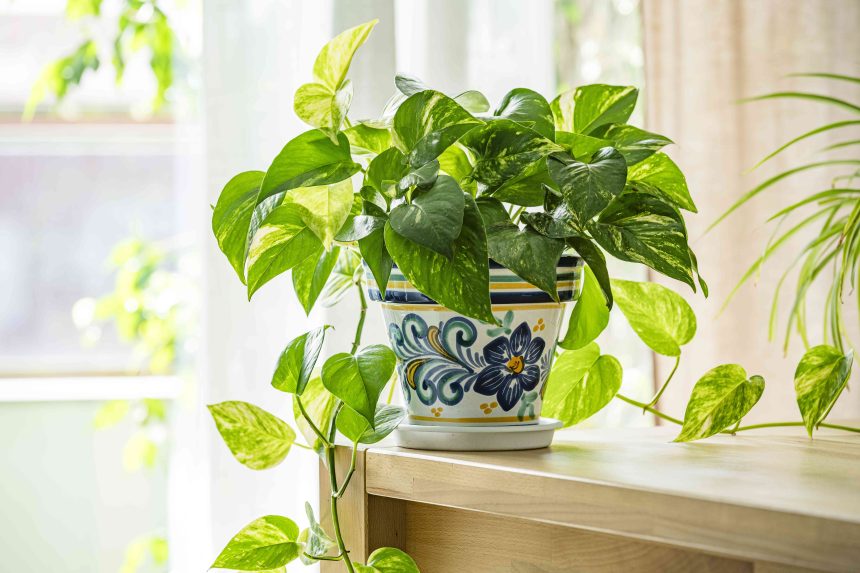With proper care, your houseplants will eventually outgrow their containers and need to be moved into bigger ones. But just because you see some roots poking out of the drainage hole doesn’t necessarily mean you need to repot a houseplant immediately. Some varieties can tolerate being in a home that is slightly too small for them, as this can prevent overwatering and encourage flowering.
With that in mind, being root-bound can still be stressful for plants, so you shouldn’t let them live that way for years. But some plants handle being root-bound very well, which is great if you chronically overwater your plants. Ahead, we asked horticulturists to share the houseplants that can handle being root-bound. Here’s what they said.
Orchid Cactus
Courtesy of Costa Farm
Orchid cactus (Epiphyllum oxypetalum) is a true cactus, so it thrives with bright light and well-draining soil. “Keeping an epiphyllum pot bound encourages blooming and prevents root rot from overwatering,” says Linda Langelo, horticulture specialist at Colorado State University. These plants typically only need to be repotted every two years. “Repotting too soon can damage and stress the root system,” Langelo adds.
- Size: 8 to 10 feet tall x 2 to 3 feet wide
- Care requirements: Bright, indirect light; well-draining soil
Hoya
Getty Images
Wax plant (Hoya spp.) is a trendy houseplant thanks to its thick leaves that come in various shapes, sizes, colors, and textures. One variety, hoya kerii, is even shaped like a heart. “Most bloom if they get plenty of light with clusters of attractive star-shaped flowers that are often fragrant,” says Justin Hancock, horticulturist for Costa Farms.
Hoyas are relatively slow growers and incredibly drought-tolerant. “Their slow growth, drought tolerance, and susceptibility to rotting if they’re overwatered (which can happen more easily in a large pot) has given them the reputation that they like being root-bound,” says Hancock.
- Size: 2 to 4 feet tall x 2 feet wide
- Care requirements: Low to bright, indirect light; well-draining soil
Ripple Peperomia
Courtesy of Gardenia
Ripple peperomia (Peperomia caperata) can tolerate being root-bound for a short time to encourage more flowering. If you repot this plant too soon, it will put its energy into growing roots rather than blooms. “Transplanting triggers hormones responsible for root development such as auxins, gibberellins, brassinosteroids, strigolactones, and others,” says Langelo.
- Size: 8 inches tall x 8 inches wide
- Care requirements: Bright, indirect light; well-draining soil
Aloe
Albina Yalunina / Getty Images
Aloe (Aloe vera) will tolerate being root-bound because its leaves store water, making it drought-tolerant. “When plants are root-bound the root system cannot supply enough water, nutrients, and oxygen to the rest of the plant,” says Langelo. “But as a succulent, it can remain root-bound for some time.”
Aim to repot this plant every two to five years. “Repotting too soon can place the plant in unnecessary transplant shock,” Langelo adds. “After repotting an aloe, it may suffer from root or stem rot.”
- Size: 12 to 24 inches tall x 6 to 12 inches wide
- Care requirements: Bright, indirect light; cactus or succulent potting soil
Chinese Money Plants
Kimie Shimabukuro/Getty Images
One of Martha’s favorite houseplants, Chinese money plants (Pilea peperomioides) can be slightly confined in their containers. “Being root-bound aids the plant in creating a fuller shape by growing in width rather than height,” says Langelo. Repot these plants every one to two years in a slightly bigger container, as transplanting can be stressful on them.
- Size: 12 inches tall x 8 to 12 inches wide
- Care requirements: Bright, indirect light; well-draining soil
Kalanchoe
Kalanchoe (Kalanchoe blossfeldiana) is a succulent that tolerates being slightly root-bound. Transplanting it to a larger container too early can damage the root system and thereby stunt its growth or kill it, says Langelo. Wait to repot kalanchoe until you see some of the roots emerging from the drainage holes in the container, which can take two to five years.
- Size: 18 inches tall x 24 inches wide
- Care requirements: Bright, indirect light; cactus or succulent potting soil
Peace Lily
Peace lilies (Spathiphyllum wallisii) like to be root-bound for a bit, which helps them flower and prevents roots from rotting, says Langelo. If peace lily is repotted before it’s ready, you may end up with a wilted plant or stunted growth.
- Size: 1 to 4 feet tall x 1 to 4 feet wide
- Care requirements: Bright, indirect light; well-draining soil
Snake Plant
Oscar Wong/Getty Images
Snake plant (Dracaena spp.) is a relatively slow-growing, drought-tolerant plant with thick, sword-like leaves that can handle being root-bound. “They’re so tolerant of being root-bound that I once kept one in a terra-cotta pot for far too long and it ended up cracking open the pot from the pressure the roots were putting on it,” says Hancock. That said, growth will slow if you go too long before transplanting snake plant.
- Size: 12 to 36 inches tall x 6 to 36 inches wide
- Care requirements: Low to bright light; well-draining soil
Spider Plant
Lynne Brotchie / Getty Images
Spider plant (Chlorophytum comosum) is a classic houseplant that features long, almost grassy, variegated leaves. “As it grows, it often sends out little plantlets on long, arching stems,” says Hancock. “It holds up pretty well to stress—including being root-bound. A little stress from being root-bound can encourage it to produce more plantlets.”
- Size: 12 inches tall x 24 inches wide
- Care requirements: Bright, indirect light; well-draining potting soil
Holiday Cactus
Getty Images
As the name implies, holiday cactus (Schlumbergera bridgesii) is a favorite during the holiday season. “This cactus hails from tropical rainforests and has thick, fleshy stems that produce stunning orchid-like flowers in a range of colors,” says Hancock.
Like hoya, the holiday cactus is an epiphyte that can be easily overwatered. The danger of overwatering and the idea that stress can help induce flowering have given this plant a reputation for wanting to be root-bound, says Hancock.
- Size: 12 to 24 inches long x 24 inches wide
- Care requirements: Bright, indirect light; well-draining potting soil
Golden Pothos
Grumpy Cow Studios / Getty Images
Golden pothos (Epipremnum aureum) is a trailing houseplant that thrives in hanging baskets, putting on a show with its green leaves that are splashed with cream and gold. This plant tolerates being root-bound really well because of its drought tolerance, says Hancock.
- Size: Up to 20 feet long x 3 to 6 feet wide
- Care requirements: Bright, indirect light; well-draining potting soil
Echeveria
Getty Images
Echeveria (Echeveria spp.) tend to have relatively small root systems and are susceptible to overwatering. “If you plant them in too large of a container and the potting mix holds more moisture than the plants can take up, it can easily lead to root rot,” says Hancock. For this reason, many succulents have a reputation for liking to be root-bound.
- Size: 1 to 12 inches tall x 4 to 8 inches wide
- Care requirements: Bright, indirect light; cacti and succulent mix







